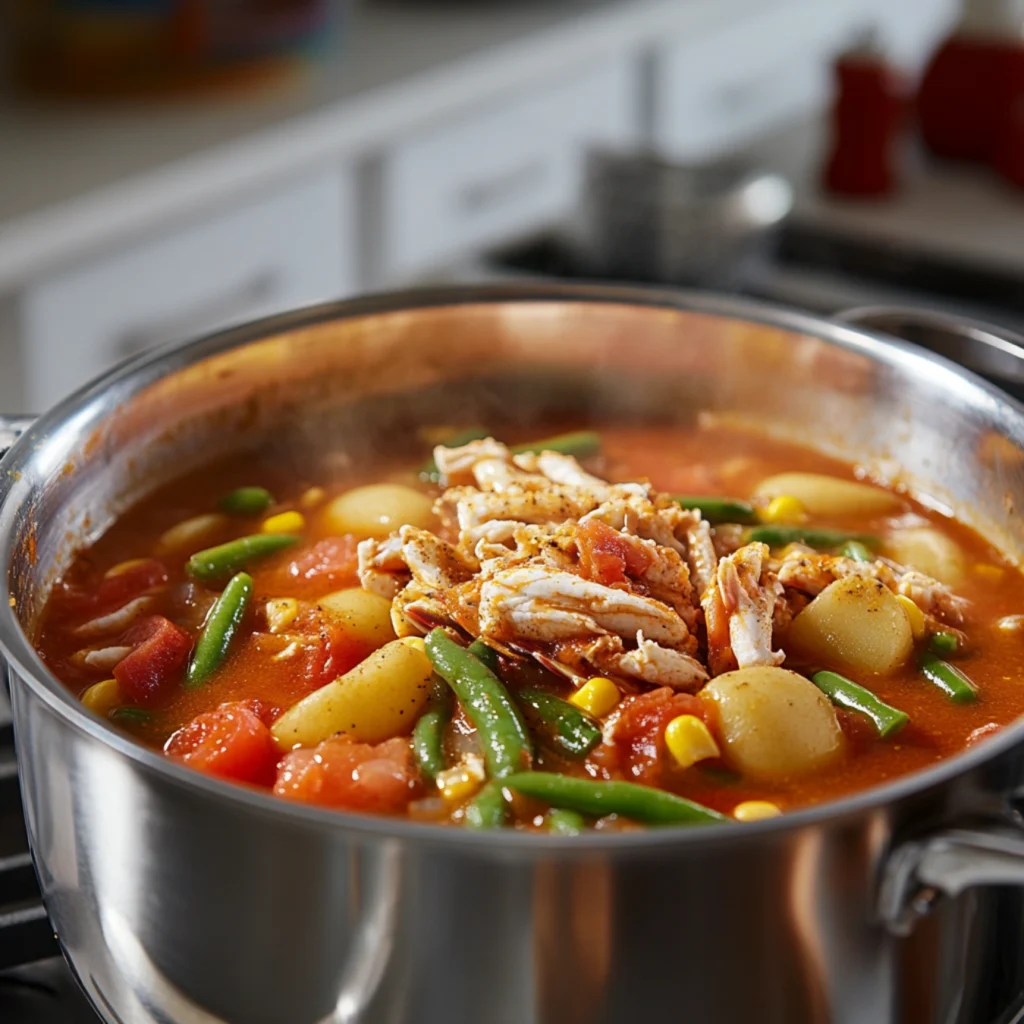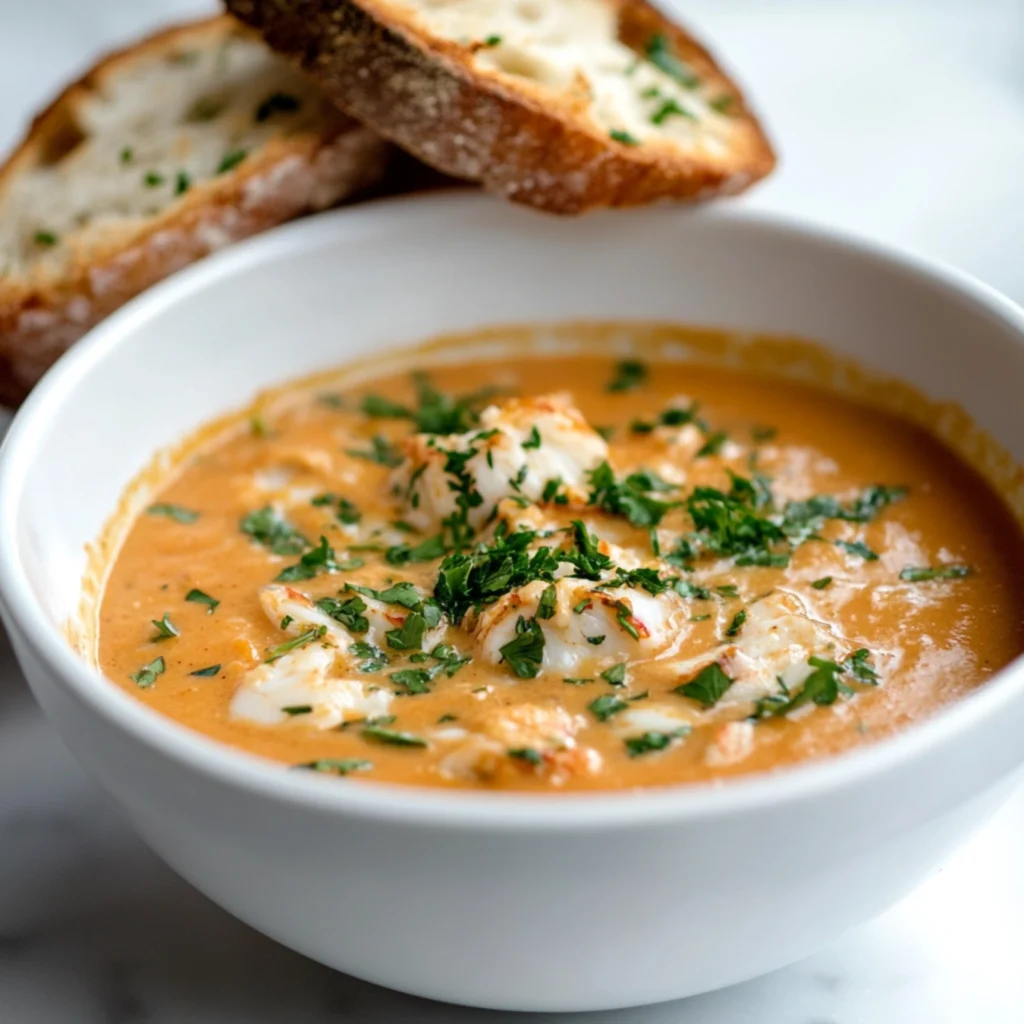This Maryland crab soup recipe is a must-try if you’re seeking a thick, substantial, and flavorful soup! Loaded with lump crab meat, fresh veggies, and a tomato-based broth all seasoned with Old Bay for that unique Chesapeake taste this classic East Coast meal is Perfect for cold days or when you’re yearning for a taste of the shore. This is the ideal mix of savory, somewhat spicy, and soothing!
Table of Contents
Why You’ll Love This Recipe
- Complete with fresh seafood flavor. Crab, Old Bay, and a strong tomato broth together are a marriage made in heaven.
- Loaded with vegetables, a rainbow of maize, potatoes, green beans, and carrots gives texture and minerals.
- Simple, fresh ingredients will let you be ready in only 45 minutes.
- Ideal for Any Season Light enough for summer yet strong enough for winter.
Ingredients
The following is what makes a great Maryland-style crab soup:
Soup Base
- The main feature of the Soup Base is lump crab meat (fresh or canned!). Sweet, delicate, and strongly flavored.
- Chicken broth or seafood provides a strong, tasty basis.
- Diced tomatoes with juice give the soup a sour depth.
- Tomato Sauce thins and improves the body of the soup.
Aromatics and Vegetables
- The aromatic basics for developing taste are onion and garlic.
- Classic soup vegetables with great crispness and sweetness are carrots and celery.
- Potato (diced) makes the soup heartier.
- Regarding the veggies, green beans have a fresh, somewhat crisp accent.
- Fresh or frozen maize kernels give texture and a delicious taste.
- Optional Lima Beans bring a rich, earthy quality.
Seasoning & Flavor Enhancement
- Old Bay Seasoning: That real Maryland taste depends on this.
- The basic seasons to improve taste are Salt and black pepper.
- Smoked Paprika gives depth and a trace of smokiness.
- Dried thyme offers an earthy, herby scent.
- Bay Leaf provides the soup with a subdued, fragrant richness.
- Umami and richness are added with Worcestershire Sauce.
- For sautéing the aromatics, butter or olive oil.
- A brilliant and fresh final garnish is fresh parsley.
- Lemon wedges for serving improve the seafood taste.
👉 The complete ingredient list with measurements is in the recipe card below!
Recipe for Maryland-Style Crab Soup
Step 1: Sauté the Aromatics
Over medium heat, warm butter or olive oil in a big pot. Add cut onion, garlic, celery, and carrots. Sauté until softened and aromatic, three to four minutes.
Step 2: Create the Foundation
Stir in seafood broth, tomato sauce, diced tomatoes (with juice), diced potatoes, Old Bay, Salt, black pepper, smoked paprika, thyme, Worcestershire sauce, and bay leaf. After gently boiling, lower the heat to low. To let the tastes marry, cover and simmer for twenty minutes.
Step 3: Add the Vegetables
Stir in lima beans, corn, and green beans. Simmer until the veggies are soft, another ten minutes.
Step 4: Add the Crab Meat
Fold gently in the lump crab meat, careful not to break it too much. Simmer to warm for five more minutes.
Step 5: Finish and Present
Remove the bay leaf and toss. Garnish with fresh parsley. Present hot beside lemon wedges on a side tray. Perfect dinner combines with oyster crackers, crusty toast, or a side of cornbread!

When mentioning how to build a flavorful broth, reference Old-Fashioned Vegetable Beef Soup Recipe for a hearty soup alternative.
Pro Advice on the Perfect Maryland Crab Soup
If possible, choose fresh lump crab meat for the greatest texture and taste.
Let the soup simmer; the flavors will mix wonderfully the longer it cooks.
Add more Old Bay to Taste: Drizzle in a little extra if you enjoy that trademark Maryland seasoning!
Mash some potatoes into the liquid for a heartier consistency in a thinner soup.
Spice it to make it interesting: Add more red pepper flakes or a drizzle of hot sauce for a kick.
How Should One Present ?
Serving Suggestions
- This robust, delicious crab soup goes especially well with crusty bread for dipping.
- Ideal for seafood soups, serve with oyster crackers.
- For a rather sweet variation from the spicy soup, serve with cornbread.
- A very consoling side dish is a grilled cheese sandwich.
Storage and Make Ahead
Managing Leftovers
Once the soup cools entirely, refrigerate it in an airtight container for up to three days.
Slowing Down
Freeze for up to three months in a container suitable for freezing. Thaw in the refrigerator overnight; then reheat.
Reheating
Reheat on the hob under medium-low heat, stirring now and then. Heat in 30-second spurts, stirring between each one in a microwave.

FAQs
1. Can I substitute imitation crab for lump crab meat?
Indeed, but actual lump crab meat tastes and textures far better. Although imitation crab is less expensive, the soup will not be rich.
2. Should Old Bay seasoning not be available? What then?
Combine the following to create a rapid replacement:
- One tsp. Paprika
- Halved teaspoon of celery salt
- Quarter teaspoon of black pepper
- Quarter teaspoon of cayenne
- Quarter teaspoon of garlic powder
3. Could a slow cooker make this soup?
Surely! To the slow cooker, add all ingredients except crab meat and parsley; simmer on low for six to eight hours. During the last thirty minutes before serving, stir in the crab meat and parsley.
4. In what ways does Maryland Crab Soup differ from Cream of Crab Soup?
Whereas Cream of Crab Soup is rich, creamy, and more akin to a bisque, Maryland Crab Soup is tomato-based with veggies. Though Maryland’s style is lighter and heartier, both are great!
Conclusion
This Maryland Crab Soup is a classic, tasty dish that is easy to cook at home. It’s the best warming seafood soup with its sweet lump crab meat, flavorful tomato broth, and well-seasoned veggies. Present it with your preferred bread and savor Maryland right in your kitchen! 😋

Maryland Crab Soup
Equipment
- Large Pot
- Wooden spoon
Ingredients
For the Soup
- 1 lb lump crab meat fresh or canned
- 4 cups seafood or chicken broth
- 1 can (14.5 oz) diced tomatoes with juice
- 1 cup tomato sauce
- 1 small onion diced
- 2 cloves garlic minced
- 2 carrots sliced
- 2 stalks celery chopped
- 1 cup green beans trimmed and chopped
- 1 cup corn kernels fresh or frozen
- 1 cup lima beans optional
- 1 medium potato diced
- 1 tsp Old Bay seasoning or more to taste
- 1/2 tsp salt
- 1/2 tsp black pepper
- 1/2 tsp smoked paprika
- 1/2 tsp dried thyme
- 1 bay leaf
- 1 tbsp Worcestershire sauce
- 1 tbsp butter or olive oil
- 2 tbsp fresh parsley chopped
- lemon wedges for serving
Instructions
- In a large pot, heat butter or olive oil over medium heat. Add diced onion, garlic, carrots, and celery. Sauté for 3-4 minutes until softened.
- Stir in diced tomatoes, tomato sauce, seafood broth, potatoes, Old Bay seasoning, salt, black pepper, smoked paprika, thyme, Worcestershire sauce, and bay leaf. Bring to a boil, then reduce heat to low. Cover and simmer for 20 minutes.
- Stir in green beans, corn, and lima beans. Simmer for another 10 minutes until vegetables are tender.
- Gently fold in the lump crab meat and simmer for 5 more minutes.
- Remove the bay leaf. Garnish with fresh parsley and serve hot with lemon wedges on the side. Pair with oyster crackers or crusty bread.

